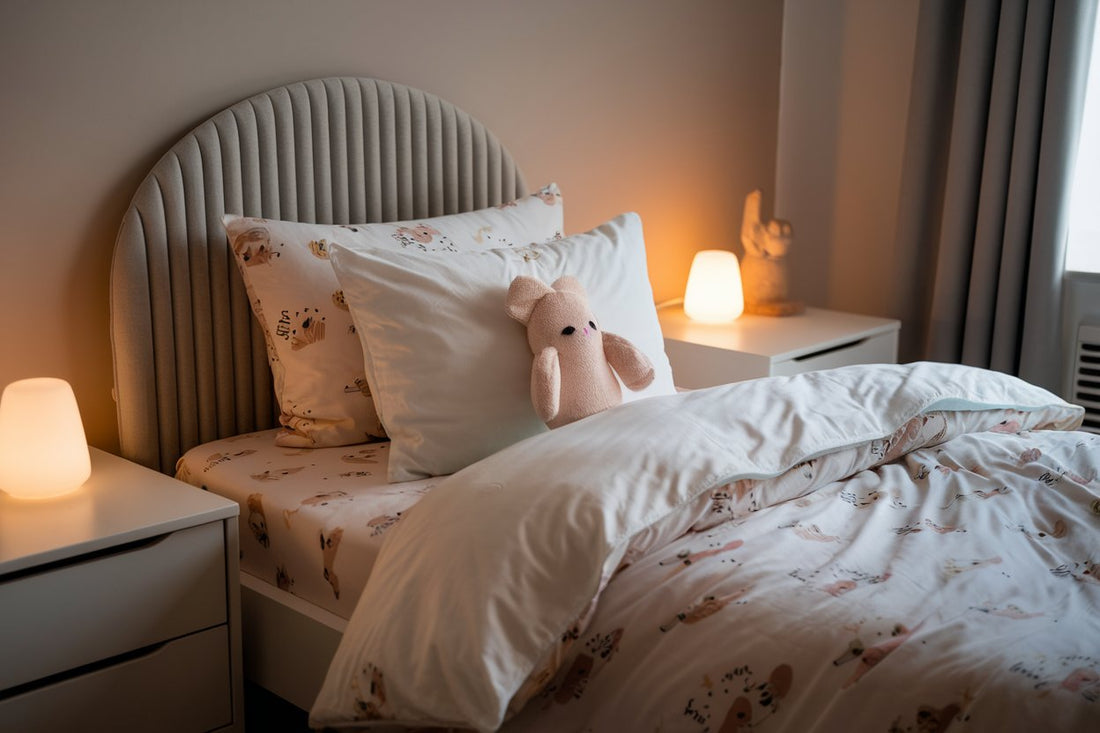Creating a Safe and Comfortable Sleep Environment for Children: How to Choose the Perfect Bedding

Introduction
Dear parents, did you know that quality sleep is the foundation of a child's healthy growth, and a set of high-quality bedding is the key to unlocking sweet dreams? Children's skin is delicate, and their immune systems are still developing, so when selecting bedding, comfort is important, but safety, environmental friendliness, and functionality are just as crucial. This article will guide you through how to choose the right bedding for your child, ensuring they enjoy quality sleep and wake up energized for the day ahead.
1. The Uniqueness of Children's Bedding
Compared to adults, children's skin is more sensitive, and their bodies are still maturing. Therefore, children's bedding needs to focus on the following aspects:
- Safety: Children's skin is less resistant to chemicals, so bedding must be free of harmful substances to ensure it is safe for their health.
- Comfort: Soft, skin-friendly materials minimize friction, allowing the child to relax and sleep comfortably, thus enhancing sleep quality.
- Functionality: Bedding with anti-mite, antibacterial, and other protective features can effectively keep bacteria and mites at bay, creating a healthier sleeping environment.
- Appeal: Bedding with fun, colorful designs can capture a child's attention, stimulate their interest, and make them more willing to use the bedding, helping them develop good sleep habits.
2. Choosing the Right Fabric: Balancing Safety and Comfort
The fabric is the core of children's bedding, as it directly touches the child’s skin. When choosing, both safety and comfort should be considered:
-
Cotton: Natural Care
Pure cotton fabric is one of the best options for children. It is soft, breathable, and adapts well to a child's sensitive skin, keeping them comfortable and dry while they sleep. Organic cotton is the best choice, as it is grown without the use of chemical pesticides and dyes, ensuring no harmful substances remain, protecting the child’s health from the start. -
Bamboo Fiber: Natural Protection
Bamboo fiber has natural antibacterial and moisture-wicking properties, effectively absorbing sweat during sleep and keeping the bed dry. It is especially suitable for children who tend to sweat more. Bamboo fiber is also soft, comfortable, durable, and eco-friendly, making it an excellent choice for modern children's bedding. -
Tencel: Comfort and Sustainability
Tencel is an eco-friendly material made from wood pulp. It is soft, smooth, and highly breathable, offering a silk-like feel for children. Its excellent moisture-wicking ability helps regulate bed temperature and humidity, which is perfect for children with sensitive skin, providing them with natural protection. -
Flannel: Warmth for Winter
Flannel is thick and provides excellent warmth, making it an ideal choice for the winter months. When selecting flannel, ensure it is of high quality to avoid shedding, which could cause discomfort to children. High-quality flannel will keep children warm during cold winter nights, providing a cozy sleep experience.
3. Choosing the Right Filling: Balancing Warmth and Health
The filling directly affects the warmth and comfort of bedding, and selecting the right filling ensures children can enjoy a comfortable sleep throughout the seasons.
-
Natural Cotton: Soft and Versatile
Natural cotton filling is soft and breathable, providing warmth that adjusts to a child’s body temperature, making it suitable for year-round use. It is hypoallergenic and gentle on sensitive skin, providing a safe and comfortable sleeping environment. -
Down: Light and Warm
Down fillings are lightweight and highly insulating, ideal for keeping children warm during the winter. When selecting down, make sure it is hypoallergenic to prevent allergic reactions. High-quality down will provide warmth and comfort, allowing children to feel cozy even during the coldest nights. -
Memory Foam: Personalized Support
Memory foam offers personalized support based on the child’s body shape, making it ideal for children who need extra protection. When choosing memory foam, ensure it is non-toxic and safe for children. Memory foam helps maintain a good sleep posture, promoting healthy growth and development.
4. Choosing the Right Color: Creating a Cozy Sleep Environment
Color affects a child’s emotions and psychology, and choosing the right color can help create a cozy and restful sleep environment.
-
Light Colors: Calm and Relaxing
Light colors (such as light blue and light pink) evoke calmness and relaxation, helping children to unwind and fall asleep more easily. These colors are soft and gentle, creating a peaceful atmosphere that is ideal for children who are easily excited or sensitive. -
Soft Tones: Warm Embrace
Soft tones (such as beige or light yellow) create a warm, inviting atmosphere, making children feel like they are being gently embraced. These colors are comforting and perfect for children who need a sense of security before bedtime. -
Bright Colors: Stimulating Creativity
Bright colors (such as green or orange) are lively and playful, sparking a child’s imagination and creativity. These vibrant colors can engage children and bring joy, making them more eager to settle into bed. However, it’s important to balance bright colors to avoid overstimulation.
5. Functional Features: Comprehensive Health Protection for Children
Modern children’s bedding often comes with various features designed to protect the child’s health and create a comfortable sleeping environment.
-
Antibacterial and Anti-Mite: Preventing Health Risks
Bedding with antibacterial and anti-mite properties helps prevent the growth of bacteria and mites, reducing the risk of allergic reactions. For children with sensitive skin or allergies, bedding with these features is particularly important. Anti-mite and antibacterial properties help create a healthier sleep environment. -
Temperature Regulation: Comfort Year-Round
Temperature-regulating bedding adjusts its warmth according to the child’s body temperature, providing comfort across all seasons. This type of bedding adapts to the child’s needs, keeping them warm or cool as needed, ensuring they stay comfortable throughout the night and promoting a restful sleep. -
Waterproof Design: Convenient and Practical
Waterproof sheets and pillowcases protect against bedwetting or accidents, which can be especially useful for younger children. Waterproof bedding is easy to clean and provides convenience for parents, keeping the bed dry and hygienic.
6. Design and Patterns: Engaging Children's Interest
The design and patterns of children’s bedding are essential in attracting their attention and encouraging them to use it, thus fostering good sleep habits.
-
Cartoon Patterns: Fun and Playful
Cartoon patterns (such as animals or beloved characters) are favorites among children. They stimulate curiosity and make bedtime more fun. Bedding with fun designs will encourage children to use it, making them look forward to going to bed every night. -
Educational Elements: Learning While Sleeping
Bedding featuring educational elements like letters, numbers, or maps not only serves as a decorative piece but also provides subtle learning opportunities. This type of bedding helps children learn while they sleep, making bedtime a more enriching experience. -
Personalized Designs: Unique and Special
Offering personalized bedding allows for unique designs based on the child’s preferences and needs. Personalized bedding helps children feel special and more attached to their sleeping space, making them more likely to adopt good sleeping habits.
7. Environmental Friendliness and Sustainability: Creating a Greener Future for Children
Choosing environmentally friendly bedding not only protects a child’s health but also contributes to sustainable development. In today’s world, where environmental awareness is growing, selecting eco-friendly bedding helps ensure a healthier future for your child.
-
Organic Materials: Natural Protection
Organic cotton, Tencel, and other eco-friendly materials are produced following strict environmental standards, reducing the use of chemicals and minimizing potential harm to children’s skin. Organic bedding provides natural protection, while also supporting sustainable farming practices. -
Sustainable Production: Eco-Friendly Choices
Brands that use sustainable production methods reduce energy consumption and waste production during manufacturing. Choosing bedding from such brands means you are supporting environmental conservation while also providing safe, healthy products for your child. -
Recyclable Packaging: Reducing Pollution
Opting for bedding that comes in recyclable or biodegradable packaging helps reduce plastic waste and environmental pollution. Recyclable packaging not only promotes reusability but also contributes to a cleaner, greener planet.
 8. Maintenance and Care: Extending the Life of Bedding
8. Maintenance and Care: Extending the Life of Bedding
Proper maintenance and care will extend the lifespan of children’s bedding, keeping it in good condition while ensuring hygiene and comfort.
-
Washing Frequency
It is recommended to wash bedding once a week to keep it clean and free from dust, sweat, and bacteria. Regular washing ensures a hygienic environment and reduces allergens that could affect the child’s health. -
Washing Methods
Depending on the fabric, select the appropriate washing method. For example, cotton bedding can be machine washed, but it’s important to choose a mild detergent free of harsh chemicals. For delicate fabrics like silk, hand washing is recommended to preserve their quality. Proper washing methods ensure the longevity and comfort of the bedding. -
Drying and Storage
After washing, avoid direct sunlight when drying bedding to prevent fading or fabric damage. Store bedding in a cool, dry place to prevent mold and odors. Proper drying and storage ensure the bedding remains in good condition for future use.
Conclusion
Dear parents, a child’s sleep quality is crucial to their physical and mental development. Selecting the right bedding can not only improve sleep quality but also protect their health and well-being. When choosing, we must focus on the fabric’s safety, the functionality of the bedding, its appeal to the child, and its environmental impact. We hope this guide helps you choose the best bedding for your child, creating a safe, comfortable, and enjoyable sleep environment for them. Let them wake up every day refreshed, happy, and ready to grow!
